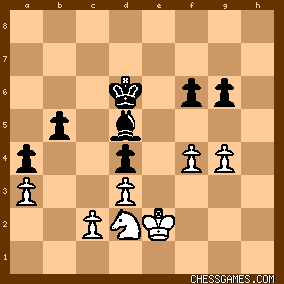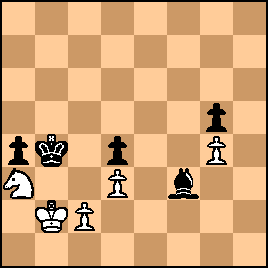| Aug-11-04 | | arielbekarov: INVITATION to Göteborg, Sweden 1920 !
This is a game played between Richard Réti vs Akiba Rubinstein in Göteborg 1920. Réti was eventually winning this great tournament, but he lost in a very refined creation against Rubinstein. For me chess is as well an art created by two persons. This game and especially the finale is according to a book that I have in French translated from Polish a great endgame strongly recommended for studying. I can only agree ! The original title of the book is (in my interpretation) AKIBA RUBINSTEIN or The Art of executing Endgames. Writer : IM Krzysztof Pitel
interpreted from Polish into French by Bernard Sojka
Editor : HATIER, Paris, 1984
ISBN 2 218 06866 4
[I use the word interpreter instead of translator.]
It must also be told that bouth French and English are foreign languages for me as my mothertongue is Swedish. This is how the writer begins commenting this particular game: "We have here one of the most famous endgames really to be found in the literature of chess. It's a beautiful example of how to use the advantage of an active bishop in contrast to a knight forced only to act in a defensive role." With pleasure I invite you to have a look at this game and I am eagerly waiting for your comments. In between I will write the annotations from M.Euwe, R.Fine,
E.Bogoljubov, I.Rabinowicz, Razouwaiev and the writer K.Pitel himself.
Welcome !
Ariel |
|
| Aug-11-04 | | arielbekarov: INVITATION !
A reminder to analyse the great game
Réti vs Rubinstein in the year of 1920 in one of the most beautiful cities on this planet - GÖTEBORG ! This city is a must to visit at least twice still 2004 or later !! Welcome, Bienvenue, Willkommen, Välkommen and Baruch haba !
Ariel |
|
| Aug-11-04 | | Whitehat1963: Not really that interesting of a game. |
|
| Aug-11-04 | | Zenchess: Rubinstein was a master of positions in which the B is stronger than the N. |
|
| Aug-12-04 | | arielbekarov: This a very subtle and refined game that needs to be re-played several times and then deeply analysed. I love the sparkling explosions, but also the refined sqeezing !
<Whitehat1963> give it chance ! There is much to learn here !
Ariel |
|
| Aug-12-04 | | nikolaas: Reti's anly lost game from that tournament which he won with 9½/13. Rubinsteinlost three times (Bogolyubov, Mieses and Möller) so he lacked 1 point. |
|
| Aug-12-04 | | Zenchess: For starters, hardly anybody's ever played 5. g3?! since this game, everybody's played 5. Nxd5 and 6. d4. I think White was in too much of a hurry to trade down. That allowed ...Ba4, turning the c2 pawn into a target. |
|
| Aug-13-04 | | e4Newman: -24...f4 seems to seal the fate of white's N
-and perhaps white's K could have been more active
-nice going for black to trade off both R
-the threat of p=Q is stronger than actually achieving it |
|
| Aug-13-04 | | Zenchess: Yeah, 24. f4 looks like a wasted move here. 24. Nf3 would have saved a tempo over the game. |
|
Aug-25-04
 | | nasmichael: <zenchess> In the comment <"Hardly anybody's ever played 5.g3?! since this game, everybody's played 5.Nxd5 and 6.d4..."> why do you think this is so; is it because The Book says it is a waste, in which case it may truly be one, or that one of the Masters (I am curious as to which one) says it is a waste, and others have followed (some wisely, some blindly) that advice. Of those few who have played g3 in this position, is that just in this database, or in www.Chesslive.de and NorBase and other large game databases as well. Would correspondence players say the same, and what are the alternatives? Does anyone in the community know this answer? I am curious to know more about the topic, even if it turns out to be a minor one. The board has many options, and sometimes there are solutions that are not looked into until one person says,
"Here is one you missed." Then everyone says, "Everybody will play this now." On the other hand, sometimes a move is required in some well-studied sequence, and to do otherwise will leave an imbalanced position in strong favor of the opponent. |
|
Aug-25-04
 | | nasmichael: Thank you, <arielbekarov>, in your conducting us on the journey to Goteborg, Sweden. This game is very instructive, and the play in the endgame is very much worth studying. I appreciate the background information you gave to us and the enthusiasm with which it was presented. Well done! I will have to check on this book, upon your recommendation. |
|
| Aug-26-04 | | e4Newman: Aside from the great endgame, I appreciate the handling of white's fianchettoed B. For me, placing too many black pieces on that diagonal, early in the game, has proven to be disasterous. 6...Nxc3 helps solve that problem, and also double white's pawns. |
|
| Aug-27-04 | | Zenchess: <nasmichael> Just compare the activity of the light-squared bishop in A Planinc vs D Dobrev, 1970 and this game; the White bishop is an active participant in the Planinc game. In this game, the Bishop is just a spectator until it gives itself up for a powerful Black Knight. Also, see Gligoric vs Larsen, 1959, where Gligoric plays the crazy 13. Kd3!?; not only does he get away with it, he has the game under control the whole time. Again, note the activity of the light-squared Bishop. |
|
Sep-26-04
 | | nasmichael: Excellent examples, <ZenChess>. That is the kind of response I can use well. Thank you for your examples and comments. |
|
Sep-26-04
 | | An Englishman: Good Evening: nasmichael, you might also be interested in Spassky-Ciric 1962, Spassky vs D Ciric, 1962 |
|
| Jul-16-07 | | Karpova: An absolutely fantastic game by Rubinstein!
35.gxh5 gxh5 36.h4 Ke6 and black wins as the King invades the enemy's territory. |
|
| Aug-14-17 | | Saniyat24: Stained glass on Richard's Chapel...! |
|
| Sep-09-21 | | Albertan: Riddle Solved:Reti could have held Rubinstein to a draw: https://en.chessbase.com/post/riddl... |
|
| Oct-15-23 | | Gaito: 
click for larger view
WHITE TO MOVE
Rubinstein conducted the whole game very ably, but the ending was especially well played by him. In the diagrammed position Réti played 45.Ne4+? which only accelerated White's defeat. But White was lost anyway, no matter how he played. For example, after 45.Nb1, the engine Komodo 13 gives the following winning variation for Black, which would have been easy to play by such and endgame virtuoso as Rubinstein: 45.Nb1 Kc5 46.Kd1 b4 47.Kc1 bxa3 48.Nxa3 Kb4 49.Kb2 g5! 50.fxg5 fxg5 51.Nb1 Bc6 52.Na3 Bf3, winning outright. (See diagram below):

click for larger view |
|





